Bosch Fuel Pump Installation Guide
Most of you already know about the Bosch fuel pumps
and their capabilities, so we'll skip to the processes of installation
in this section.
There are two ways to install the fuel pump....in-tank and in-line. The in-tank installation is the most difficult method, so
we'll begin with a few basics regarding fuel tank / pump relationships,
followed by the in-line install.
The first thing that enthusiasts must fully understand
is the relationship that must exist between the fuel pick-up and the bottom
of the gas tank. If the fuel pick-up isn't resting on the floor of the
in-tank baffled sump, the car will not have full access to all the gas
in the tank. We've never particularly appreciated cars that run out of
gas before the gauge says "EMPTY", so unless you want to assume the risk,
pay attention to the following drawing.
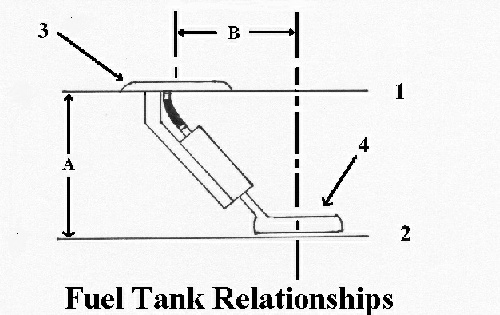
The relationship (A) between the top of the tank (1)
and the bottom (2), as well as (B), the distance from the between the centerlines
of the access lid (3) and the fuel pick-up (4) must be carefully adhered
to, whenever the fuel pump is altered in any way. It's essential that the
fuel pick-up be placed correctly relative to the bottom of the tank, or
it won't have the ability to "reach" all the fuel in the tank.
We suggest that enthusiasts take the stock fuel pump
assembly and build a simple fixture, which will locate the access lid and
the fuel pick-up assembly before doing any disassembly, or modifications.
This fixture will enable you to preserve the original component alignment,
while precisely placing all the components of the new assembly.
Fixtures may be built from pretty simple materials, such as
three lengths of 1"x2" wood, a few dry-wall screws and some
cyanoacrylate (superglue). Remember..."functional is beautiful" and
you'll probably only use the fixture once, so don't get carried away...and
unless you show it to a friend, nobody will ever know what it looked like.
In-Line Installation
For greatest efficiency, the inline installation of
this high performance fuel pump should be accompanied by the removal of
the stock in-tank pump. Pumping fuel through the stock fuel pump would
simply create a tremendous pressure drop on the inlet side of the Bosch
pump and diminish it's ability to perform the way it was designed.
The job of replacing the stock pump with a flow-through
tube is really pretty easy. It requires removal of the access lid and the
attached bracket, fuel pump, and pick-up assembly. Once it's removed from
the tank, the relationship between the lid and the pick-up should be noted
for duplication.
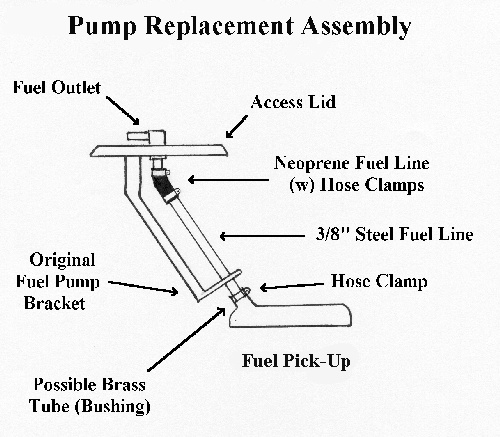
We suggest that the stock fuel pump be replaced with an
appropriate length of 3/8" steel automotive fuel line available from any
auto parts store. A piece of 5/16" neoprene (high pressure) fuel line can
be used to attach the tube to the access lid. Use (2) 5/16" hose clamps for
the connection at the top. The pick-up can be attached to the lower portion of
the tube after trimming the stock "tang" off with a Dremel. A
3/8" to 7/16" hose clamp will hold it in place securely.
* On some installations, a 3/4" length of 13/32"thin
wall brass tubing (available at hobby shops or hardware stores) may need
to be slipped over the end of the steel tube to make the lower fitment
to the pick-up a tight seal. The brass tube may be sweated in place with
some solder.
The two ends of the bracket that supported the bottom
of the stock fuel pump may be bent together to touch and support the new
steel tube on each side.
For more industrious enthusiasts, greater efficiency may be
gained by complete replacement of the short steel fuel line in the access lid
and the tubing behind it. The original 90 degree fitting in the tank lid may be
cut off and the hole enlarged and tapped to 1/4" pipe threads. Drill the
bottom of the threaded part of a 1/4" x 3/8" 90 degree steel or
brass fitting to a true 3/8". Tighten the new fitting into the threads of
the lid, making sure to aim the new outlet in the preferred direction, and
insert the 3/8" tube from the bottom and solder the assembly in place (both
the fitting to the lid and the tube into the fitting.) Bend the tube and cut it
to the proper length to locate the pick-up properly. Slip a washer with a
3/8" hole onto the tube, then bend the foot of the bracket to the sides of
the tube (below the washer). The washer will now sit on the lower portion of the
bracket. Solder it into position to support the new tube. The rest of the
assembly is just as above. Using this method will permit the use of 3/8"
high pressure fuel line directly from the lid to the intake end of the pump, as
well as removing all potential restrictions.
Before looking at the parts involved with the in-line
mount assembly, we'll take a look at a schematic that should make the entire
operation a little clearer to those who have never done this before.
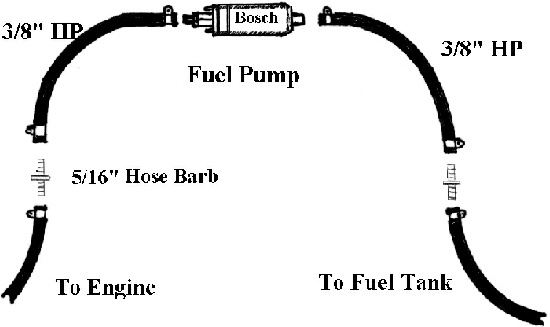
Next we'll have a look at the actual hardware necessary
to do this installation.
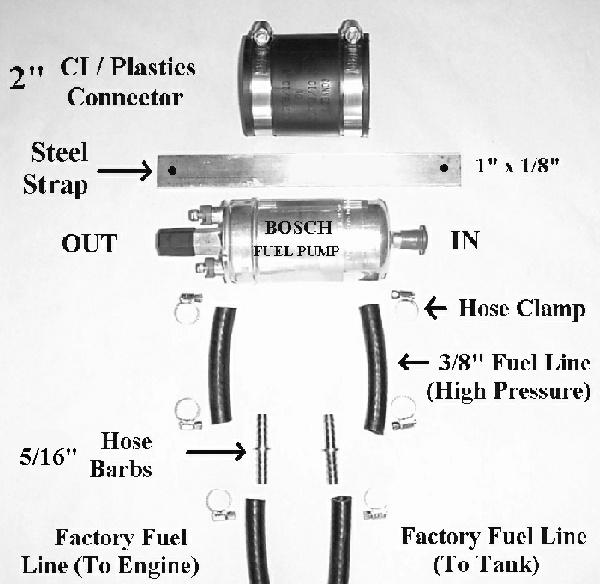
All of the pictured components are available from local
auto supplies and hardware stores.
The use of high pressure neoprene fuel line is necessary
with any fuel injection system, so don't scrimp and buy the standard (and
cheap) fuel line. The hose barbs will allow you to step from the 3/8" pump
fittings to the 5/16" (I know they're metric) fuel lines.
The steel strap is for mounting the pump assembly under
the car and it'll be pictured below.
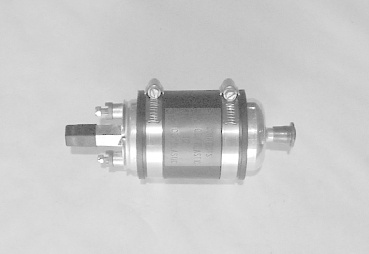
The 2" PVC connector tube makes an excellent vibration
and noise deadening material to house the pump in and it also makes mounting
the pump to the 1" x 1/8" steel strap easy with the large hose clamps that
come with it.
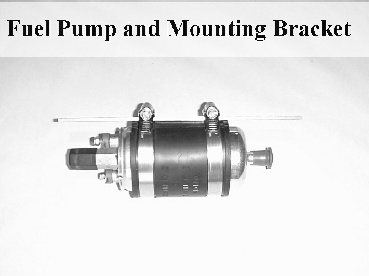
The best location for mounting the in-line fuel pump is
beside the fuel tank. Most Hondas have an ideal space on the left side of the
fuel tank for pump location, since this is the side where the gas filler is
located. The mounting bracket should be attached in two places to the unibody,
where the stock plastic shield is located. Self tapping screws will do the job
nicely and it's relatively easy to fashion a cover for the entire area, once the
install is complete.

The stock Honda fuel pump wiring can be extended to
reach the connections on the Bosch pump. It's easiest to route the wires
through a small hole in the rubber surround where the fuel lines enter
the car's interior on the left side under the rear seat. It's not necessary
to dramatically increase the wire size, as the Bosch pump uses less current
than the stock (or Walbro) fuel pump.
In-Tank Installation (As Promised)
I'm starting off with a diagram of the stock pump assembly
and I'll emphasize one more time that the proper component relationships
must be maintained.
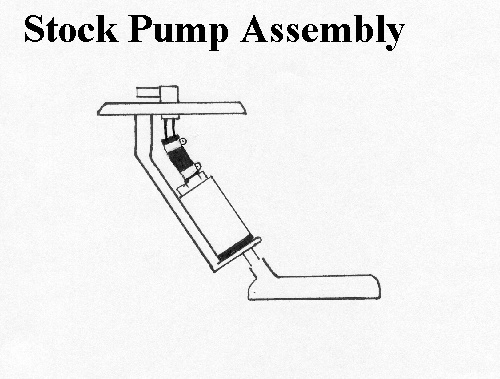
Now, I'm following up with a diagram showing the Bosch
pump clamped to the bracket assy.
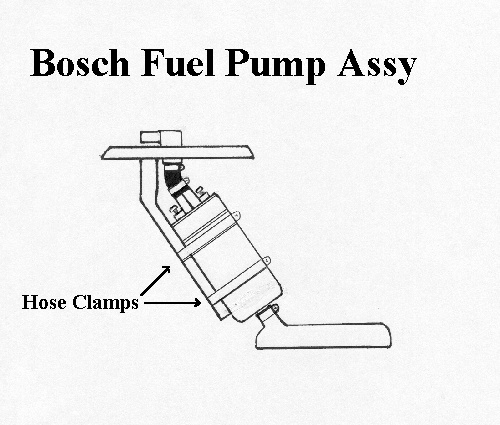
When mounting the Bosch pump in-tank, the stock steel
return line will need to be reduced in length so it's terminated just above
the pump, as the overall package size will be too large to pass through
the hole in the tank. I recommend searching for hose clamps that have small
diameter screw mechanisms, as fitment through the hole will be an issue.
You will need to saw the lower "foot" off the
stock bracket because the new pump body is considerably longer. The stock
pick-up will install over the inlet end of the pump once the tang is removed
from the side. You'll also need to stuff a tissue into the pick-up and use a
Dremel with a sanding drum to open-up the top to make it fit the OD of the pump
inlet.
The stock wiring can be re-terminated and secured to
the new posts. Insulation around the new terminations doesn't need to seal
tight, since gasoline isn't a conductor
Prior to the final install of the assembly, making
a silicon "O" ring around the neoprene tank gasket will be worthwhile,
as it's a real bummer to bolt it all together only to find there's an air
leak...especially after the rear seat's back in. (Wonder why we know about
that???)
We've done installs on a couple dozen cars like this,
so it can be done. I believe that once you've done it once, the job is
relatively easy, but finding the combination on the first can be a trying
experience, with only the knowledge that you'll never need to screw with
it again as the reward.
Having done a few in-line installations during the
past 4-5 months, I've concluded that the in-line mounting is quieter and
it's a lot easier (to me). I'm not sure what it'd take to make any
of us do the in-tank install again, but it'd have to be real "special".
I'm going to follow this up with some quick in-tank
instructions that I have provided a few enthusiasts, who have cursed a
lot, but successfully accomplished the installation. I'll try to accumulate
some pictures to show some of this in the real world setting, but we're
not going to pull one out of a tank for pictures anytime soon...so it could
be a while. Happy installation!
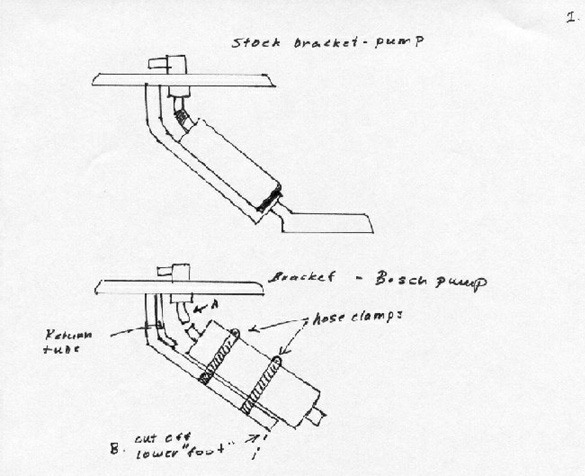
A. Shorten tube to allow new pump to fit as far upward as possible.
Leave enough room to slip neoprene "high pressure" fuel line on tube
with hose clamp to tighten.
B. Out off bottom "foot" from bracket. It's also possible
that you'll need to shorten the return line tube. We typically shorten it
so it doesn't extend below teh first hose clamp that retains the pump.

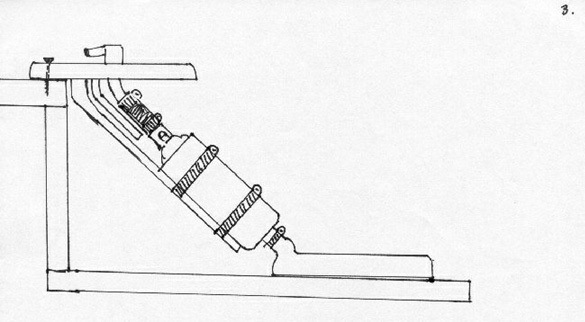
Use some
rings to attach the wiring to the pumps. I recommend that the large
clamp which attach the pump to the bracket use the smallest tightening
screws you can find. You should be able to insert the complete
pump/plate/pick-up assembly into the tank. You (might) need to bend
some of the internal baffling to make it fit.
|